|
With Movies
I played several action-oriented DVDs, evaluating the RT-12d for mid-bass
dynamics, audible artifacts (muddiness, cone cry, rattling), deep extension
and output compression. My overall subjective home theater ratings for the
RT-12d are provided in the table below, with a rating of 5 being the best
score:
|
Evaluation Criteria |
Rating (1-5) |
Summary Comments
|
|
Mid-Bass Dynamics |
4.00 |
Muscular mid-bass output,
with plenty of punch. |
|
Audible Artifacts |
4.50 |
Minimal artifacts, even at
high playback volumes. |
|
Deep Extension |
3.75 |
Digs to 22 Hz in-room
before roll-off. |
|
Deep-Bass Compression |
5.00 |
Outstanding; does not
compress deep bass dynamics prior to electronic limiter engaging.
|
Provided below are screen shots and spectral color charts
from a few bassy scenes in the movie I, Robot.
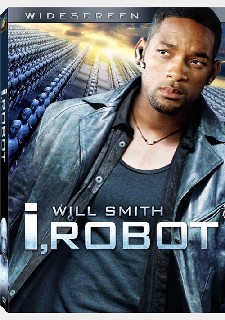 These spectral color
charts were electronically recorded directly from the DVD, and show where
the deep bass occurs on a given passage, with dark red and pink colors being
the highest amplitude. These spectral color
charts were electronically recorded directly from the DVD, and show where
the deep bass occurs on a given passage, with dark red and pink colors being
the highest amplitude.
To determine the maximum audibly clean output of the RT-12d on these scenes
in my 2,000 ft3 evaluation room, I increased the master volume until I noted
either audible artifacts or a loss of dynamic headroom. Then I backed off
until an audibly clean and dynamic presentation was restored. Peak sound
pressure levels were monitored at the listening position with a B&K SPL
meter set to C-weighted Fast.
Detective Spooner finally spots Sonny robot hiding in the
parts bins. Sonny responds dramatically, bursting forth and jumping over the
startled Spooner as parts fly everywhere. The RT-12d didn't disappoint on
this scene, exhibiting lively dynamics and punching out a quick burst of
sound pressure.
|
Scene Description |
Time Stamp |
Maximum SPL |
|
Sonny robot bursts from parts
bin. |
0:20:14 |
106 dB |
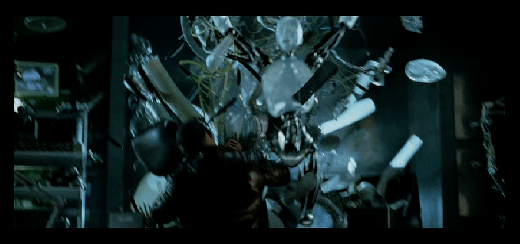

Suspecting the injured Sonny robot will return to USR for
repairs, Spooner makes haste for that destination in his hot-rod police
cruiser, blowing past the viewer down a highway tunnel. This scene contains
strong content across the entire usable bass spectrum, and is a good test of
broadband dynamic output capability. The RT-12d passed with flying colors,
hitting loud and hard with no audible strain or compression.
|
Scene Description |
Time Stamp |
Maximum SPL |
|
Transport car blows past in
tunnel. |
0:22:08 |
105 dB |


Hell-bent on eliminating the meddling Spooner, the
demolition robot activates and swings into action. This scene contains a
brief but very loud blast at 50 Hz, followed by strong content in the 65-75
Hz region. The big Klipsch had me ducking for cover on this scene,
displaying excellent upper bass dynamics.
|
Scene Description |
Time Stamp |
Maximum SPL |
|
Demolition robot activates. |
0:39:31 |
108 dB |
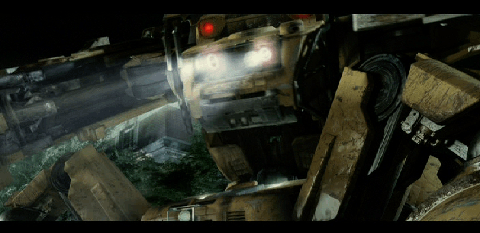

Spooner's luck turns for the worse as two USR robot
carriers execute a flanking attack in the highway tunnel. Containing 35
seconds of continuous broadband bass content, this scene is a torture test
for any subwoofer. As I pushed the master volume to commercial cinema
playback levels, the RT-12d shook the room with authority. At 52:45, a USR
carrier sweeps past the screen. This event features a strong 28 Hz impulse
in addition to the already heavily saturated bass mix. This mondo LFE hit
caused the electronic limiters in the RT-12d to briefly engage to protect
the subwoofer from overload. The limiter is effective without being
intrusive; the RT-12d simply stopped getting louder without any signs of
audible distress.
|
Scene Description |
Time Stamp |
Maximum SPL |
|
USR carriers approach In tunnel. |
0:52:12 - 0:52:47 |
104-106 dB |


After suffering a major beating at the hands of the
renegade robots, Spooner finally loses control of his cruiser and slams into
a concrete wall at high speed. The RT-12d walloped the room hard on the
collision, feeling very strong in the mid-bass regions.
|
Scene Description |
Time Stamp |
Maximum SPL |
|
Spooner's car hits wall. |
0:55:11 |
106 dB |


With Music
I evaluated the RT-12d on several music selections for balance, definition,
pitch, coherence, and deep extension. As stated previously, the auto-EQ
feature really improved the sound quality of the subwoofer (especially on
music), and I highly recommend the use of this feature for critical music
listening. My overall subjective music ratings are provided in the table
below.
|
Evaluation Criteria |
Rating (1-5) |
Summary Comments
|
|
Balance |
3.50 |
Good octave-octave
balance. |
|
Definition |
3.50 |
Decent mid-bass
articulation. |
|
Pitch |
3.00 |
Pitch is well-preserved at
normal playback levels. At high playback levels open E is
slightly pitchy. |
|
Coherence |
3.00 |
Adequate coherence and
rhythm & pace. |
|
Deep Extension |
3.75 |
Fine for all popular
music, only lacking the 17 Hz extension required for pipe organ. |
Provided below are some listening notes from a few CDs.
1) For Duke - Bill Berry & the Ellington All Stars, Miller & Kreisel
Sound Corporation, 1978 Original Master Recording, 1995 20-Bit High
Resolution Digital Master. This is a wonderful classic jazz CD.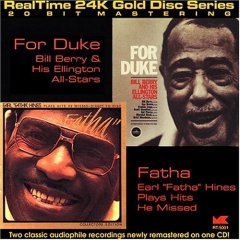 Perdido features Ray Brown plucking his way through one very funky upright
bass solo. The RT-12d handled the upright bass well, realistically conveying
the timbre of this instrument, however at live jazz club playback levels I
found open E to sound slightly pitch-altered.
Perdido features Ray Brown plucking his way through one very funky upright
bass solo. The RT-12d handled the upright bass well, realistically conveying
the timbre of this instrument, however at live jazz club playback levels I
found open E to sound slightly pitch-altered.
2) Everything Must Go - Steely Dan, Reprise Records High Resolution
DVD-A, 2003.
"Godwhacker" opens with a well recorded bass kick drum, and the RT-12d
sounded tight and focused, with just a hint of overhang.
3) Still Bill – Bill Withers, Columbia Records 1972, Legacy Records
2003. Almost everyone over the age of 35 recognizes the keyboard hook in Use
Me Up, and this famous song is still popular in current movie soundtracks.
The RT-12d played the funky bass foundation and the complex single/double
syncopated kick drum line well. Bass guitar timbre was realistic and each
kick drum strike was easy to differentiate and sounded suitably percussive.
4) 1,2, To The Bass – Stanley Clarke, Sony Music Entertainment, Epic
Records, 2003. I challenged the RT-12d to keep up with Stanley's amazing
unplugged bass solo Touch recorded live at the famous Yoshi's jazz house and
Japanese restaurant. Rhythm and pace were acceptable but not outstanding on
this very difficult recording, with some minor blunting of bass transients
noted.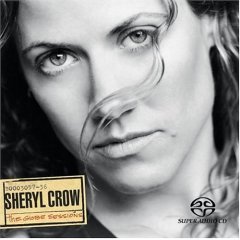
5) The Globe Sessions – Sheryl Crow, AM Records 2001, DTS-ES 6.1
Discrete. The RT-12d provided a solid emotional foundation to the soulful
tune Crash and Burn, sounding natural and realistic on the subtle bass
guitar and gentle tom-tom strikes.
6) Sound Hound Classical Organ CD - Artist Unknown, 2003. I popped in
this internet forum cult-classic recording to see how well the RT-12d
handled 32 foot pipe organ music. Track 9 Be Thou My Vision contains a
sustained 17 Hz note at the 1:30 mark which was simply too deep for the
RT-12d to accurately and cleanly reproduce. Other pipe organ notes in the 22
Hz and above region were played much better, with usable sound pressure and
tactile response.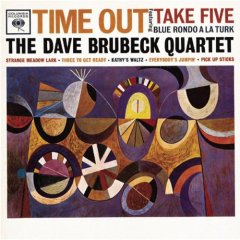
7) Time Out - The Dave Brubeck Quartet, Columbia Records/CBS, 1959
(1997 Direct Digital Remaster). Eugene Wright displays masterful finger work
on Three To Get Ready, and the RT-12d stayed detailed and lively, blending
well with the mains and staying pitch accurate on low E up to moderately
loud playback levels.
8) Kiss My Axe - Al DiMeola, Rhino Records, 1988 (1991). The RT-12d
displayed good attack on the extremely dynamic mini-kettle strikes, with a
powerful and realistic decay signature.
Click Here to
Go to Part V.
Terms and Conditions of Use
|

 These spectral color
charts were electronically recorded directly from the DVD, and show where
the deep bass occurs on a given passage, with dark red and pink colors being
the highest amplitude.
These spectral color
charts were electronically recorded directly from the DVD, and show where
the deep bass occurs on a given passage, with dark red and pink colors being
the highest amplitude. 









 Perdido features Ray Brown plucking his way through one very funky upright
bass solo. The RT-12d handled the upright bass well, realistically conveying
the timbre of this instrument, however at live jazz club playback levels I
found open E to sound slightly pitch-altered.
Perdido features Ray Brown plucking his way through one very funky upright
bass solo. The RT-12d handled the upright bass well, realistically conveying
the timbre of this instrument, however at live jazz club playback levels I
found open E to sound slightly pitch-altered.



